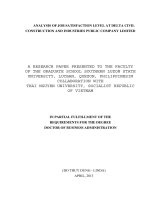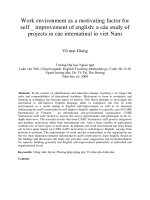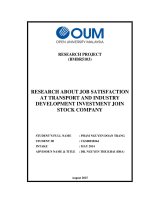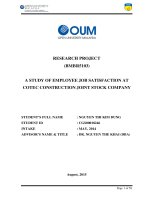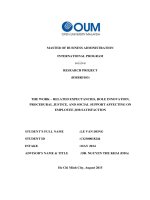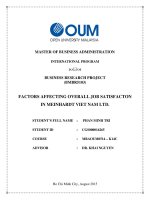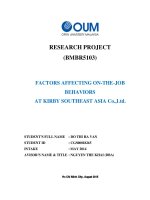Consequences of job satisfaction at pyramid consulting viet nam LTD
Bạn đang xem bản rút gọn của tài liệu. Xem và tải ngay bản đầy đủ của tài liệu tại đây (1.6 MB, 66 trang )
RESEARCH PROJECT
(BMBR5103)
CONSEQUENCES OF JOB SATISFACTION
AT PYRAMID CONSULTING VIET NAM LTD.
STUDENT’S FULL NAME
:
TRUONG QUANG VINH
STUDENT ID
:
CGS00018521
INTAKE
:
SEPTEMBER, 2014
ADVISOR’S NAME & TITLE
:
NGUYEN THE KHAI, DBA
September 2015
Advisor’s Assessment
-------------------------------------------------------------------------------------------------------------------------------------------------------------------------------------------------------------------------------------------------------------------------------------------------------------------------------------------------------------------------------------------------------------------------------------------------------------------------------------------------------------------------------------------------------------------------------------------------------------------------------------------------------------------------------------------------------------------------------------------------------------------------------------------------------------------------------------------------------------------------------------------------------------------------------------------------------------------------------------------------------------------------------------------------------------------------------------------------------------------------------------------------------------------------------------------------------------------------------------------------------------------------------------------------------------------------------------------------------------------------------------------------------------------------------------------------------------------------------------------------------------------------------------------------------------------------------------------------------------------------------------------------------------------------------------------------------------------------------------------------
Advisor’s signature
Page 1 of 65
ACKNOWLEDGEMENTS
This research is made possible through the help and support from everyone,
including: teacher, family, friends and in essence, all sentient beings. Especially,
please allow me to dedicate my acknowledgment of gratitude toward the following
significant advisors and contributors:
First and foremost, I express deep and sincere gratitude to Dr. Nguyen The Khai for
his most support, guidance, encouragement, suggestion and very constructive
criticism have contributed immensely to the evolution of my ideas on the research.
Second, I am very much thankful to Ms. Do Thi Thanh Truc for her valuable
guicance, keen interest and encouragement at various stages of my data analysis on
SPSS software.
Finally, thanks to the board of managers and all employees of PYRAMID
CONSULTING VIET NAM LTD., and all of my friends for their precious
comments and helps to collect data for this thesis.
Page 2 of 65
TABLE OF CONTENTS
LIST OF FIGURES ............................................................................................................. 5
LIST OF TABLES ............................................................................................................... 6
ABSTRACT .......................................................................................................................... 7
Chapter 1: INTRODUCTION ............................................................................................ 8
1.1
Motivation of the study ......................................................................................... 8
1.2
Significance of the study ....................................................................................... 9
1.3
Purpose of the study ............................................................................................ 10
1.4
Question of the study .......................................................................................... 10
1.5
Introduction of Pyramid ..................................................................................... 10
1.5.1
Company overview ...................................................................................... 10
The history of formation and development of the company ................................... 11
Vision ........................................................................................................................... 12
Mission ......................................................................................................................... 13
Core Value ................................................................................................................... 13
Products/Services ........................................................................................................ 13
Organization chart ..................................................................................................... 15
1.5.2
Personnel structure ...................................................................................... 17
Chapter 2: LITERATURE REVIEW .............................................................................. 18
2.1
Job satisfaction .................................................................................................... 18
2.2
Organizational commitment .............................................................................. 20
2.3
Positive work behaviors ...................................................................................... 22
2.4
Voice behaviors.................................................................................................... 23
2.5
Helping behaviors................................................................................................ 24
2.6
The relationship between job satisfaction and organizational commitment . 26
2.7
The relationship between job satisfaction and positive work behaviors........ 26
2.8
The relationship between job satisfaction and voice behaviors ...................... 27
2.9
The relationship between job satisfaction and helping behaviors .................. 27
Chapter 3: RESEARCH MODEL AND HYPOTHESES .............................................. 29
3.1
Research model.................................................................................................... 29
3.1.1
Independent Variable .................................................................................. 29
Page 3 of 65
3.1.2
Dependent Variables.................................................................................... 29
3.2
Research Hypotheses .......................................................................................... 30
3.3
Instruments .......................................................................................................... 31
3.4
Research Participants ......................................................................................... 33
3.5
Procedure for Data Collection and Analyze ..................................................... 33
Chapter 4: RESULTS AND FINDINGS ......................................................................... 35
4.1
Reliability statistic ................................................................................................ 35
4.2
Descriptive statistic .............................................................................................. 36
4.3
Correlation statistic .............................................................................................. 36
4.4
Hypothesis Testing Result .................................................................................. 38
4.4.1
Hypothesis 1 Testing Result ........................................................................ 38
4.4.2
Hypothesis 2 Testing Result ........................................................................ 39
4.4.3
Hypothesis 3 Testing Result ........................................................................ 40
4.4.4
Hypothesis 4 Testing Result ........................................................................ 41
5.1
Summary and Discussion ................................................................................... 43
5.2
Management Implications .................................................................................. 44
5.3
Limitations and Further Research Recommendations .................................... 45
REFERENCES................................................................................................................... 47
APPENDIX A ..................................................................................................................... 54
APPENDIX B ..................................................................................................................... 60
Page 4 of 65
LIST OF FIGURES
Figure 1 – Organization chart of Pyramid Consulting Vietnam Ltd. ......................15
Figure 2 – Organization chart of Pyramid Consulting Vietnam Ltd. .......................16
Figure 3 – Proposed Research Model of consequences of job satisfaction in
Pyramid .....................................................................................................................29
Page 5 of 65
LIST OF TABLES
Table 1: Product/Services of Pyramid Company ......................................................14
Table 2: Employees by Age-range ...........................................................................17
Table 3: Employee by Gender ...................................................................................17
Table 4: Employees by Degree .................................................................................17
Table 5: Reliability statistics ....................................................................................35
Table 6: Descriptive statistics ...................................................................................36
Table 7: Correlations ................................................................................................37
Table 8: Model Summary (H1) .................................................................................38
Table 9: Coefficientsa (H1) .......................................................................................38
Table 10: Model Summary (H2) ...............................................................................39
Table 11: Coefficientsa (H2) .....................................................................................39
Table 12: Model Summary (H3) ...............................................................................40
Table 13: Coefficientsa (H3) .....................................................................................40
Table 14: Model Summary (H4) ...............................................................................41
Table 15: Coefficients a (H4) ....................................................................................41
Page 6 of 65
ABSTRACT
This study examined the impact of job satisfaction on organizational
commitment, positive work behaviors, voice and helping behaviors in Pyramid
Consulting Viet Nam ltd. Data was collected through the use of standardized
questionnaires. Questionnaires were given personally to 295 employee of
Pyramid Company; there were 309 questionnaires returning and completely
responses were used for the statistical analysis. The collected data were computed
and analyzed through factor analysis, Cronbach’s Alpha, descriptive statistics,
correlation, and multiple regression analysis. Result: The results supported the
hypothesis that job satisfaction has significant relationship with organizational
commitment, positive work behaviors, voice and helping behaviors. Conclusion:
The results can provide the reference for Management Team about the relationship
between Job Satisfaction (JS) with Organizational Commitment (OC), Positive
Work Behaviors (PB), Voice Behaviors (VB), and Helping Behaviors (HB) in
Pyramid Company. This research would help Pyramid Company to reform human
resource strategies that involved work factors such as positive work behaviors or
voice and helping behaviors to improve the management of human resource
development. These strategies would help in influencing positive behaviors among
employees, and hence achieve effectiveness and high productivity in the
organization. This result of study has valuable implications for the Human
Resources Department of Pyramid Company to improve its policies in order to
improve job satisfaction.
Keywords: Job satisfaction, organizational commitment, positive work behaviors,
voice behaviors, helping behaviors.
Page 7 of 65
Chapter 1: INTRODUCTION
Pyramid Consulting Vietnam currently is one of the 3 largest web development
companies in Vietnam, and is the only company that provides marketing services
and e-business. With the level of service is designed to assist international
customers, Pyramid offers consulting services that take advantage of the cost and
benefits of external resources.
Pyramid has made accents and effort to build and create jobs for more fourteen
thousand employees and workers. One of the reasons for the success of Pyramid is
the number of employees.
This study explored job satisfaction support on organizational commitment,
positive work behaviors, voice and helping behaviors at Pyramid Company. This
chapter also presents the motivation of the study, significant of the study, purpose
of the study, the questions of the study and the key words of study.
1.1 Motivation of the study
Organizational goal of high priority is attainment of a high level performance
through productivity and efficiency. In order to do that highly satisfied work force
is an absolutely necessity for achieving a high level of performance advancement of
an organization. Higher satisfaction of worker may lead to higher job performance,
then the company could growth better. Thus every organization tries to create a
satisfied work force to operate the well-developing of the organization.
How does the organization create employee job satisfaction? This question is what
heads of an organization are interested in. Therefore, the relationship between
employee job satisfaction and organization commitment are necessary and should
be focused. In fact, a lot of organization didn't satisfy the employee job satisfaction
related promotion, salary so on.
Job satisfaction has been an important focal point for organizational and industrial
psychology. In defining job satisfaction the reference is often made to Locke’s
Page 8 of 65
(1976) description of job satisfaction as a “pleasurable or positive emotional state
resulting from the appraisal of one’s job or job experiences” (Jex 2002 p.116). The
appraisal involves various elements related to the job such as salary, working
conditions, colleagues and boss, career prospects and, of course, the intrinsic
aspects of the job itself (Arnold et al 1998 p. 204)
In recent years, human resource reports usually state that the number of employees
who does not understand clearly the job in the group is increasing as well as the
number of employees quit job gets increase. That may lead the company to critical
impact of leaking its skilled and well trained workforce. Not only that, it will take
huge invisible cost for the company if these well trained and qualified employees
run out of the company and come to work for the competitors.
An employee's overall satisfaction with his job can impact to the factors such as
organizational commitment, positive work behaviors, voice and helping behaviors.
Management's role in enhancing employees' job satisfaction is to make sure they
have positive work behaviors, voice and helping behaviors to encourage the
employee to accomplish the tasks they have been assigned. In order to help the
management team have an overview of the effect of job satisfaction on
organizational commitment, positive work behaviors, voice behaviors, and helping
behaviors in the organization, this study assess the validity of the relationship
among them in Pyramid Company working environment.
1.2 Significance of the study
This research is conducted in order to have an understanding of the effect of job
satisfaction on organizational commitment, positive work behaviors, voices
behaviors and helping behaviors. To let the management of the company to have a
clearer view of problems that affected the increasing employee turnover in the
company. This research focus on the opinion of employees in Pyramid Company
about the impact of job satisfaction on organizational commitment, positive work
behaviors, voice behaviors, and helping behaviors.
Page 9 of 65
1.3 Purpose of the study
The purpose of the current study is to investigate the impact of job satisfaction on
organizational commitment, positive work behaviors, voice behaviors, and helping
behaviors at Pyramid Company.
It is expected that the result of the research will give an overall view of how job
satisfaction effect on organizational commitment, positive work behaviors, voice
behaviors and helping behaviors at Pyramid Company. Then, Pyramid management
team can use the research’s results as reference to increase job satisfaction to bring
Pyramid becoming a leading company in developing software sector in Vietnam
and in the region with a sustainable development strategy.
1.4 Question of the study
This study addresses some points follow:
-
How is the impact of job satisfaction on organizational commitment of
employees at Pyramid Company?
-
How is the impact of job satisfaction on positive work behaviors of employees at
Pyramid Company?
-
How is the impact of job satisfaction on voice behaviors of employees at
Pyramid Company?
-
How is the impact of job satisfaction on helping behaviors of employees at
Pyramid Company?
1.5 Introduction of Pyramid
1.5.1 Company overview
Company name:
Pyramid Consulting Viet Nam Ltd.
Logo:
Page 10 of 65
Form of enterprise
Limited company
CEO
David Dzialowski
The number of employee
295
Location
Pyco Group: level 3, Etown 1 Building
Yellow Pepper: level 7
Atlassian: level 2, Etown 3 Building
364 Cong Hoa St., Ward 13, Tan Binh Dist., Ho Chi
Minh City
Tel
08.838123367
Business hours
Monday - Friday
Morning 9:00- 12:00
After noon 1:00- 6:00
The history of formation and development of the company
In 1999, while the future co-founders of PYCO Digital, David Dzialowski and Ofir
Ejnes, were among the first to recognize the Web’s formidable marketing potential
for multinational companies, they also realized how costly it was to develop
interactive advertising. They turned to the offshore development market: this
emerging market had highly skilled and very competitive technicians.
That same year, they founded PYCO Digital, a global provider of digital solutions.
Not only does PYCO Digital offer world-class development and consulting services
internationally, but does so at affordable costs thanks to its offshore resources. Its
strength lies in its ability to combine its experience and knowledge in the fields of
advertising and marketing, with high-end expertise in multimedia and software
development.
A third component has naturally evolved from years of offshore work in digital
marketing and web development: a deep understanding of offshoring in every aspect
which enables us to offer consulting and offshoring placement services to our clients.
Page 11 of 65
Every day, PYCO Digital strives to meet its client's exact requirements and
implement their ideas, concepts and designs into high-end digital multimedia in
Europe, America and Asia. With a team of over 400 digital experts, PYCO Digital
has the resources to fulfill any brief within the remit of Web development, Mobile
solutions, Consulting & Premium offshoring.
Pyramid Consulting Vietnam currently is one of the 3 largest web development
companies in Vietnam, and is the only company that provides marketing services
and e-business. With the level of service is designed to assist international
customers, Pyramid offers consulting services that take advantage of the cost and
benefits of external resources.
Vision
Pyramid Consulting Vietnam is a Premium Digital Consulting Company, a global
enterprise with the necessary skills and capacity to fulfill client digital deliverables at
competitive prices.
Building on 16 years of operation, Pyramid Consulting Vietnam has broadened its
initial service of web and mobile development for advertising agencies around the
globe to a full digital outsourcing and consulting company, offering multinationals
integrated services from start to finish. Pyramid Consulting Vietnam helps business
leaders re-imagine, design, build and operate a smooth digital business transition,
thanks to the knowledge of our onshore and offshore dedicated teams, with growing
outsourcing facilities in many countries.
Pyramid Consulting Vietnam's newly developed services will consolidate the
company's aim to become the best Premium offshore production centre in the world
with a focus on high-end technologies.
Our business principles and values are unwaivering and have helped us maintain
solid client relationships as well as build strong business partnerships across the
globe. Our belief is that customer satisfaction, across a wide variety of areas, is the
key to maintaining long-term relationships.
Page 12 of 65
Mission
Offering the best solutions and quality to the customer with the cutting-edge
technology combined with ongoing research and development of the company.
Establishing a team of world-class developers who are passionate and continually
learn new knowledge, to overcome all obstacles and challenges in order to succeed
in life.
Giving all shareholders the most effective business results, giving staffs the
improvements, professional and the best working environment, facilitating learning
and career development opportunities.
Core Value
Victory: the spirit of determination to achieve what was planned.
Bravery: encouraging, trying and passing all obstacles.
Innovation: keeping the spirit of innovation at work.
Sharing: sharing the information as a group (of knowledge, spirit, ideas, etc. ...)
Belief: empowering to members to perform and complete the task as possible.
Products/Services
No.
Name of products/services
01
Web design
02
Mobile and computer software developing
03
Strategic Consultant and e-business management
04
Web Application developing
05
Digital Strategic Consultant (Managing and analyzing for Digital project)
06
Management Consultant for Social communication
07
Consultant for Social application
08
Community management consultant
Page 13 of 65
09
Advertising management consultant
10
Digital design
11
UX/UI Design
12
Building Digital project (CMS, Portal, e-banking…)
13
Quality management (situation checking, unit checking, checking tools,
UAT…)
14
Tools (Jira, Confluence, Git, Sonar, Bamboo)
15
Technologies ( Magnolia, Adobe AEM, Hybrism Drupal, Magento)
Table 1: Product/Services of Pyramid Company
Source: Company profile ()
Page 14 of 65
Organization chart
Figure 1 – Organization chart of Pyramid Consulting Vietnam Ltd.
Source: Company profile ()
Page 15 of 65
Figure 2 – Organization chart of Pyramid Consulting Vietnam Ltd.
Source: Company profile ()
Page 16 of 65
1.5.2 Personnel structure
The total number of Pyramid Company’s employees is 295 (November 30th,
2015)
Employees by Age-range
Agerange
Quantity
Under 25
40
25 – 30
167
31 – 40
42
41 – 50
27
>50
19
Total
295
Table 2: Employees by Age-range
Gender
Male
Female
Total
Employees by Gender
Quantity
199
96
%
14%
57%
14%
9%
6%
%
67%
33%
295
Table 3: Employee by Gender
Employees by Degree
Degree
Quantity
Post graduate
9
Graduate
260
Diploma,
College,
26
Vocational
training
Total
295
Table 4: Employees by Degree
%
3%
88%
9%
Source: Pyramid Company Profile
Page 17 of 65
Chapter 2: LITERATURE REVIEW
This chapter presents the body of organizational literature containing the base
theory and relevant other theories used in this study. This chapter includes the
following:
-
(1) Job satisfaction
-
(2) Organizational commitment
-
(3) Positive work behaviors
-
(4) Voice behaviors
-
(5) Helping behaviors
2.1 Job satisfaction
Job satisfaction has been an important focal point for organizational and industrial
psychology. In defining job satisfaction the reference is often made to Locke’s (1976)
description of job satisfaction as a “pleasurable or positive emotional state resulting
from the appraisal of one’s job or job experiences” (Jex 2002 p.116). The appraisal
involves various elements related to the job such as salary, working conditions,
colleagues and boss, career prospects and, of course, the intrinsic aspects of the job
itself (Arnold et al 1998 p. 204)
Different authors have different approaches towards defining job satisfaction.
Hoppock defined job satisfaction as any combination of psychological,
physiological and environmental circumstances that cause a person truthfully to say
I am satisfied with my job (Hoppock, 1935). According to this approach although
job satisfaction is under the influence of many external factors, it remains
something internal that has to do with the way how the employee feels. That is job
satisfaction presents a set of factors that cause a feeling of satisfaction.
Vroom in his definition on job satisfaction focuses on the role of the employee in the
workplace. Thus he defines job satisfaction as affective orientations on the part of
individuals toward work roles which they are presently occupying (Vroom, 1964).
Page 18 of 65
One of the most often cited definitions on job satisfaction is the one given by
Spector according to whom job satisfaction has to do with the way how people feel
about their job and its various aspects. It has to do with the extent to which people
like one dislike their job. That's why job satisfaction and job dissatisfaction can
appear in any given work situation.
Job satisfaction represents a combination of positive or negative feelings that
workers have towards their work. Meanwhile, when a worker employed in a
business organization, brings with it the needs, desires and experiences which
determinates expectations that he has dismissed. Job satisfaction represents the
extent to which expectations are and match the real awards. Job satisfaction is
closely linked to that individual's behavior in the work place (Davis et al.,1985).
Job satisfaction is a worker’s sense of achievement and success on the job. It is
generally perceived to be directly linked to productivity as well as to personal
well-being. Job satisfaction implies doing a job one enjoys, doing it well and
being rewarded for one’s efforts. Job satisfaction further implies enthusiasm and
happiness with one’s work. Job satisfaction is the key ingredient that leads to
recognition, income, promotion, and the achievement of other goals that lead to a
feeling of fulfillment (Kaliski.,2007).
Job satisfaction can be defined also as the extent to which a worker is content with
the rewards he or she gets out of his one her job, particularly in terms of intrinsic
motivation (Statt, 2004). The term job satisfaction refers to the attitude and feelings
people have about their work. Positive and favorable attitudes towards the job
indicate job satisfaction. Negative and unfavorable attitudes towards the job
indicate job dissatisfaction (Armstrong, 2006).
Job satisfaction is the collection of feeling and beliefs that people have about their
current job. People’s levels of degrees of job satisfaction can range from extreme
satisfaction to extreme dissatisfaction. In addition to having attitudes about their
jobs as a whole. People also can have attitudes about various aspects of their jobs
Page 19 of 65
such as the kind of work they do, their coworkers, supervisors or subordinates and
their pay (George et al., 2008).
Job satisfaction index was developed by Schriesheim and Tsui (1980). It uses six
items to form an index that describes overall job satisfaction. The scale includes
single questions to assess the degree of satisfaction with the work itself,
supervision, co-workers, pay, promotion opportunities, and the job in general.
Job satisfaction can be considered as one of the main factors when it comes to
efficiency and effectiveness of business organizations. In fact the new managerial
paradigm which insists that employees should be treated and considered primarily
as human beans that have their own wants, needs, personal desires is a very good
indicator for the importance of job satisfaction in contemporary companies. When
analyzing job satisfaction the logic that a satisfied employee is a happy employee
and a happy employee is a successful employee.
Factors of job satisfaction
Job satisfaction is under the influence of a series of factors such as: The nature of
work, Salary, Advancement opportunities, Management, Work groups and Work
conditions.
2.2 Organizational commitment
The concept of organizational commitment refers to a person's affective reactions to
characteristics of his employing organization. It is concerned with feelings of
attachment to the goals and values of the organization, one's role in relation to this,
and attachment to the organization for its own sake rather than for its strictly
instrumental value. As a positive outcome of the quality of work experience, the
concept can be regarded as a factor contributing to subjective well-being at work.
O’Reilly & Chatman (1986) argue that commitment is best defined as the basis of
an individual’s psychological attachment to the organization. This basis of
Page 20 of 65
attachment is distinct from either the antecedents of commitment or from its
consequences. Drawing from Kelman (1958), they argue that commitment to an
organization is predicated on three separate bases of attachment: compliance,
identification and internalization. Compliance refers to instrumental attachment
undertaken for specific rewards; identification refers to attachment based on a
desire for affiliation with the organization; and internalization refers to congruence
between individual and organization values. C. A. O’ReiIIy & Chatman (1986)
further demonstrate that the consequences of commitment vary according to the
individual’s basis of attachment.
Organizational commitment is a widely researched construct in the Management
Literature (Meyer and Allen 1991; Mowday, Porter and Steers 1982; Swailes 2002;
Argyle 1989; Etzioni 1975) describes the involvement and faithfulness of employee
towards the company.
There are various definitions of the concept Organizational Commitment include
Porter’s (1974) definition which descript organizational commitment as the relative
strength of an individual’s identification with and involvement in a particular
organization.
According to Mowday, R.T., Steers, R.M., & Porter, L.W. (1979) organizational
commitment is a strong belief in and acceptance of the organization’s goals and
values; a willingness to exert considerable effort on behalf of the organization; and
a strong desire to maintain membership in the organization.
Allen & Meyer (1990) is of the view that organizational commitment has been
defined as a psychological state that binds an employee to an organization, thereby
reducing the incidence of turnover.
Batemen & Strasser (1984) believe that the aim of studying organizational
commitment are related to :
-
Employees behaviors and performance effectiveness.
Page 21 of 65
-
Attitudinal, affective and cognitive constructs such as job satisfaction
-
Characteristics of the employees’ job and role, such as responsibility
-
Personal characteristics of the employee such as age and job tenure.
Meyer & Herscovitch (2001) state that commitment is a force that binds an
individual to a course of action of relevance to one or more targets.
O’Reilly (1989) defined Organizational Commitment as
an individual's
psychological bond to the organization, including a sense of job involvement,
loyalty and belief in the values of the organization.
Schwartz & Tessler (1972) see that personal norms are introduced as a responsible
factor for what Wiener referred to as an incorporated normative pressure, which
makes organizational commitment a moral obligation because an employee feels he
or she must do so. According to Wiener & Verdi (1980), this feeling of moral
obligation measured by the extent to which an employee feels that she or he should
be faithful to organization, make an employee sacrifice to help it out and not
disapprove it.
In general, organizational commitment describes the attachment and involvement of
the employee to the organization.
2.3 Positive work behaviors
Positive work behaviors correlated positively with job satisfaction, organizational
commitment, job involvement, job tension, and general fatigue. Antagonistic
behaviors
correlated
positively with psychological withdrawal behaviors,
organizational politics, job tension, general fatigue, and burnout. Psychological
withdrawal behaviors also correlated positively with organizational politics,
turnover intentions, general fatigue, and burnout. Psychological withdrawal
behavior correlated negatively with perceived organizational support, job
Page 22 of 65
satisfaction, organizational commitment, and job involvement (Cropanzano et al.,
1997).
This measure was developed by Lehman and Simpson (1992) to describe four
categories including positive work behaviors, psychological withdrawal behaviors,
physical withdrawal behaviors, and antagonistic work behaviors. Positive work
behaviors include such things as volunteering for additional work, working
overtime, and attempting to change one’s job for the better. Psychological
withdrawal behaviors including thinking of being absent, day dreaming, excessive
chatting, and concentrating on personal tasks. Physical withdrawal behaviors
include leaving early, taking long breaks, and sleeping at work. Antagonistic work
behaviors include arguing with co-workers, disobedience of supervisors, and
gossiping.
2.4 Voice behaviors
Voice, defined as nonrequired behavior that emphasizes expression of constructive
challenge with an intent to improve rather than merely criticize (Van Dyne &
LePine, 1998, p. 109), falls clearly in the promotive-challenging cell of the Van
Dyne et al. (1995) typology. Voice is distinct from affiliative behavior (e.g.,
helping) normally associated with organizational citizenship (e.g., Smith, Organ, &
Near, 1983) or contextual performance (e.g., Motowidlo & Van Scotter, 1994; Van
Scotter & Motowidlo, 1996) because affiliative behavior (e.g., helping) is meant to
preserve or improve relationships, whereas voice is challenging and may upset
interpersonal relationships. Voice is also distinct from prohibitive behaviors such as
whistle-blowing (Near & Miceli, 1987; Miceli & Near, 1992). Whistle-blowing is
critical and meant to stop some activity as opposed to being constructive and meant
to change (improve) some activity.
Page 23 of 65
According to Van Dyne and LePine (1998) voice behavior defined as “making
innovative suggestions for change and recommending modifications to standard
procedures even when others disagree” (p. 109). Voice requires individuals to
support overarching system-level goals, allocate cognitive resources to develop
suggestions for change aimed at overcoming obstacles to system-level goals, and
take initiative in expressing suggestions. Voice also requires individuals to believe
in change as a potential way of coping with situational demands and requires them
to express their ideas in interpersonal setting (Van Dyne, Graham, & Dienesch,
1994). Additionally, and in contrast to the requirements of cooperative forms of
contextual performance, individuals who engage in voice must be change oriented
and willing to risk upsetting the status quo and interpersonal relationships – at least
in the short term. Voice behavior requires that individuals expend effort speaking
up and expressing suggestions they may have. Those who tend to be dependable
feel responsible and are more likely to make this investment of effort. Those who
are conscientious tend to be achievement oriented and are more willing to engage in
conversations about ideas intended to improve the situation. They should also be
persistent about making sure their ideas are understood.
Reluctance to share information, speak up, and provide feedback has the potential
to negatively affect employees’ trust, morale and motivation. Also, information and
ideas withholding can undermine organizational decision making, error correction
and development and innovation processes (Beer and Eisenstat, 2000). Speaking up
is positively accepted and highly praised from a lot of organizations, especially
those involved in major organizational restructuring requiring employees’ input in
order to elicit successful organizational change. Employees’ suggestions can be
very valuable during these times of change (Premeaux and Bedeian, 2003).
2.5 Helping behaviors
According to Van Dyne and LePine (1998) helping behaviors defined as promotive
behavior that emphasized small acts of consideration. Helping is cooperative
Page 24 of 65


